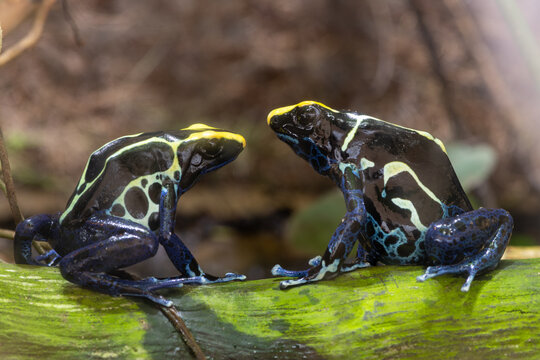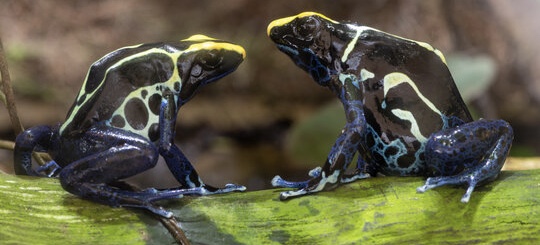ANIMAL: Dyeing Poison Dart Frog Dendrobates tinctorius Type of Animal: Frog Habitat: Humid forest, wetlands Location(s): Guiana Shield, E Venezuela, N Brazil bordering Guiana Shield/Venezuela, NE Brazil Appearance: Very colorful frog, blackish body w/ irregular yellow/white stripe pattern running along back/flanks/chest/head/belly, legs range from pale blue/sky blue/blue-gray to royal blue/cobalt blue/navy blue/royal purple often peppered w/ small black dots, highly variable coloration, many morphs occur, females larger than males Food/Diet: Ants, termites, fruit flies, crickets, beetles, spiders, mosquitoes, springtails, centipedes, insect larvae, tadpoles/froglets of own species. Tadpoles also eat algae & detritus. Status in Wild: Stable Conservation: Breeding in zoos, aquariums, & herpetoculture Lifestyle: Groups of 2-5 frogs Additional Info: Called: Male Female Young: Tadpole Group: Army Weight: Male: 0.13 oz Female: 0.23 oz Gestation: 2.5 weeks Life Span: 5-7 years in wild, 10-15 years in captivity Body Length: Male: 1.5-2 in Female: 2-2.5 in Due to skin toxins, only a few snakes eat adults. Tadpoles/froglets preyed on by adults & each other. Also called Dyeing Poison Arrow Frogs. They’re great climbers. Females lay 8-15 eggs per clutch. After eggs laid, male fertilizes them & guards them. When tadpoles hatch, tadpoles climb on male’s back & he takes them to small water body in multiple trips, where they’ll stay for 2-2.5 months. After tadpole stage, they enter froglet stage, reaching maturity at around 6 months old. 1st Poison Dart Frog species known to Europeans. Males make fairly quiet musical buzzing noises. Most active in morning & early evening. Fun Fact(s): Used in medical research due to skin toxins being possible medicine source. Hunters use skin toxins on darts & arrows. Local tribes use this species for decoration. Feathers plucked from back of young parrots & frogs rubbed on parrots’ exposed skin. When feathers regrow, toxin changes feather appearance making it brighter. Altered feathers highly prized. Often hybridize w/ closely related Blue Poison Dart Frogs in captivity. Bright colors serve as warning to most potential predators. While highly poisonous in wild, they lose much/all of toxicity in captivity due to diet. In captivity, they’re only fed nontoxic prey items like crickets & fruit flies. In wild, they eat lots of ants, termites, & poisonous beetles.

